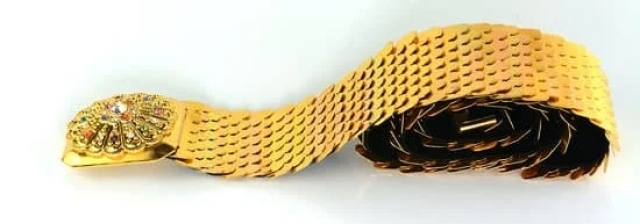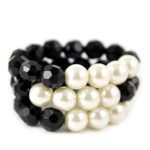Metal poisoning from jewelry is a real risk that should not be overlooked, despite the fact that many people enjoy wearing statement pieces without consideration of the potential health risks. The most common metals associated with metal poisoning include aluminum, cadmium, lead, and mercury.
In some cases, these metals may be found in large doses in the form of plated jewelry or costume jewelry made with low-cost materials. It is important to be aware of the fact that even small amounts ingested through skin contact can cause serious health issues if left unchanged over a long period of time.
Symptoms Of Metal Poisoning From Jewelry The symptoms of metal poisoning from jewelry vary depending on which kind of metal is causing the reaction. For instance, aluminum toxicity can lead to confusion and dizziness, while lead poisoning can result in vision problems and headaches. Mercury exposure can result in anemia and cramps, while cadmium toxicity may cause vomiting and fatigue.
In severe cases, it can cause permanent nerve damage or brain damage. Irrespective of which metal is causing the issues it is important that medical treatment be sought as soon as possible as a delay could make recovery more difficult.
Treatments For Metal Poisoning From Jewelry Treating metal poisoning from jewelry depends on which type of metal is causing the reaction and how much has been ingested by the person affected. Treatment will often involve removing any jewelry crafted with contaminated metals as well as limiting exposure to further contamination sources such as consumer products like makeup, shampoo or deodorant containing metals.
Your doctor may also prescribe medication to counteract any heavy metal build-up in your body such as chelating agents or diuretics depending on your unique situation. Additionally dietary modifications may help reduce absorption rates from contaminated food sources such as seafood and certain fruits and vegetables grown with contaminated soil.
Types of Metal Poisoning
The most commonly discussed type of metal poisoning is caused by contact with jewelry, specifically costume jewelry and other ornaments. While gold, silver, and platinum are unlikely to cause any harm as they are often hypoallergenic (and therefore non-toxic), there are other metals that can prove toxic if worn for an extended period of time without proper precautions. These include nickel, lead, cadmium, beryllium, chromium, cobalt, arsenic, zinc and manganese.
Lead Poisoning
One of the most dangerous types of metal poisoning is lead poisoning; this is largely due to the fact that lead has been used in everything from drinking water pipes to toys over the years. Lead can be ingested or absorbed through skin contact with objects such as jewelry containing a significant amount of lead.
Exposure primarily occurs through direct contact with objects made of lead-containing materials or through inhalation of airborne particles containing lead. The metal can build up in the blood stream over time and cause a variety of health issues such as seizures and behavioral issues in young children; it can also cause infertility in adults.
Nickel Poisoning
Another type of metal poisoning that frequently results from wearing certain jewelry or costume items is nickel poisoning. Nickel exposure typically occurs when people come into contact with items containing nickel alloys-most commonly costume jewelry and zippers on clothing-for long periods without precautionary measures.
The symptoms vary depending on the amount exposure but generally include irritations including redness and swelling at sites where the metal comes into contact with skin as well as itching rashes. In more severe cases there may be liver damage caused by high levels of circulating nickel ions in bloodstream and other issues such as irregular heart rhythm caused by prolonged exposure to high levels of nickel ions in airways and alveoli.
Cobalt Poisoning
Cobalt is another common metal found in jewelry and clothing that can cause metal poisoning if exposed to for too long.
Cobalt poisoning usually causes skin problems such rashes, blisters, lesions or discoloration at sites exposed to cobalt-tainted objects like zippers on clothing or bracelets made out of cobalt-alloyed metals., In severe cases it can also result in neurological damage since cobalt ions can enter the body system via inhalation or ingestion causing issues including memory problems and cognitive decline.
People who work closely with cobalt should always take safety precautions including using protective masks when needed to reduce chances of inhaling high concentrations from the air.
What Metals Can Cause Metal Poisoning When Worn in Jewelry
Metal poisoning, also known as heavy metal toxicity, is a medical condition caused by exposure to certain metals found in jewelry and clothing accessories. Common metals that can cause metal poisoning when worn in jewelry are as follows:
- Nickel – Nickel is the most common metal found in necklaces, rings, earrings and other types of jewelry. Exposure to nickel can lead to allergic reactions such as contact dermatitis, coughing and wheezing.
- Lead – Lead-based compounds are often used in costume jewelry due to their low cost. It is known to cause skin irritations and liver disease.
- Cadmium – Cadmium is a common component of costume jewelry products such as rings, earrings and pendants. Prolonged exposure to cadmium may cause kidney failure or lung cancer.
- Mercury – Mercury is another common component of some pieces of jewelry which can lead to neurotoxicity if ingested. Symptoms may include numbness, weakness and tingling sensation in the extremities.
How To Prevent Metal Poisoning
The best way to prevent metal poisoning from jewelry is by avoiding contact with any items that contain these toxic metals. When purchasing items for personal use or gifts for others, it is important to ensure they are made from hypoallergenic materials or contain safe concentrations of any metal used. One should always inspect an item closely before purchasing it and read the label carefully for information on its materials and composition.
Additionally, when wearing jewellery containing precious metals make sure there are no visible signs of damage or corrosion. When attending parties or festivals where many people could be exposed to the same jewellery make sure you wear your own rather than sharing with others. Finally, pay attention any symptoms you may experience after wearing a piece of jewellery which could indicate metal poisoning such as rashes, eczemas or neurological symptoms like difficulty concentrating.
Diagnosis Of Metal Poisoning
The diagnosis of metal poisoning primarily depends on a comprehensive examination including physical signs and systems together with lab tests such as blood tests, urine tests and X-rays. After laboratory results show evidence of toxicity caused by certain metals doctors may then conduct further tests in order diagnose the particular source causing the poisoning, whether this be from surface contact (such as wearing jewellery) inhalation (from living near factories) or oral ingestion (consuming food containing harmful levels).
In cases where jewellery has been identified as a source for heavy metal toxicity treatment will dependent on the type and severity hazards posed by a particular level exposure.
Signs and Symptoms of Metal Poisoning
Metal poisoning can occur from wearing jewelry containing metals such as nickel, cadmium, cobalt and lead. When heated to body temperature, the metal is released into the skin and absorbed by the body. Metal poisoning can cause skin irritations known as an allergic contact dermatitis.
This condition causes redness and swelling of the area around the jewelry as well as patches of dry, scaly skin or a rash-like appearance. In more severe cases of metal poisoning symptoms may also include headaches, nausea, vomiting, difficulty breathing, depression and joint pain.
Diagnosis
People who are experiencing signs of contact dermatitis should consult with a healthcare provider for proper diagnosis. The physician will determine if metal poisoning is the cause by taking a detailed medical history and conducting a physical exam that includes testing for any underlying infections or allergies which could be causing the irritation.
If these tests come back negative, then a patch test should be done where small amounts of metal alloys are placed on the patient’s arm to rule out an allergic reaction to specific metals.
Treatment
Once metal poisoning has been diagnosed your physician will likely recommend that you stop wearing any jewelry containing highly allergenic metals until they have identified which type it contains so that you can switch to less toxic alternatives like stainless steel or titanium in order to avoid future problems. You may also need to take antihistamines daily and use topical ointments or creams until full recovery has been achieved.
In cases where metal poisoning is particularly severe medical interventions such as dialysis or surgery may need to be considered.
Common Causes of Metal Poisoning from Jewelry
Metal poisoning from jewelry is a dangerous reality that consumers should be aware of, especially if they are wearing pieces with lower grade metals. Jewelry made with nickel, lead, arsenic and cadmium can all cause metal poisoning, which is why understanding the sources of these chemicals is critical.
Nickel Poisoning
Nickel poisoning commonly occurs in jewelry made from cheap alloys containing nickel. Even jewelry that is labeled ‘nickel free’ may contain trace amounts of nickel, so it’s important to check the materials label before purchase. Long-term exposure to small amounts of nickel can result in allergies or cancer.
Lead Poisoning
Lead poisoning is typically found in costume jewelry and cheap watches. This heavy metal accumulates in the body and has toxic effects on the nervous system. Long-term exposure to lead – which can occur when wearing lead-based jewelry – can cause cognitive delays in children even at low levels of exposure.
Arsenic Poisoning
Arsenic poisoning often arises from jewelry made with pewter or other copper alloys that contain traces of arsenic. Although small amounts of this chemical can be beneficial for humans, excessive exposure causes several chronic ailments such as cardiovascular illness and certain types of cancer.
Cadmium Poisoning
Cadmium poisoning is also a risk with certain types of costume jewelry containing zinc-cadmium alloy plating – usually found on bracelets or necklaces – The presence of cadmium in jewelry can affect internal organs such as kidneys and lungs which may result in renal dysfunction and pulmonary diseases if exposed for long periods over time without proper protection from the metal itself.
Tips for Avoiding Metal Poisoning from Jewelry
The term “metal poisoning” is used when a person has been exposed to too much of a certain metal, usually through the skin, and experiences negative health effects. Earrings, jewelry that contains nickel or other metals, can potentially lead to this poisoning in individuals who are susceptible.
Here are some tips for avoiding metal poisoning from jewelry:
- Only wear jewelry made from non-toxic metals such as gold or sterling silver.
- Apply clear nail polish over the metal parts of the jewelry to form a protective barrier between you and the metal.
- Look for hypoallergenic jewelry labeled “nickel free” or “lead free.”
- Regularly clean your jewelry with a mild soap and warm water.
- If wearing earrings, make sure to avoid any part touching your skin directly.
In addition to wearing the right kind of jewelry, it’s important to pay attention to any reactions you may have. If you experience itching, redness, swelling, or any other sign that you could be having an allergic reaction, remove the item immediately and contact your doctor for advice.
When shopping for jewelry, look out for labels like “hypoallergenic”, “sterling silver”, and “gold plated.” Steer clear of pieces made from nickel-plated alloys or alloys containing zinc coated copper. While these items may look nice now, they could be harmful in the future if they cause irritation on your skin.
Natural and Traditional Treatments for Metal Poisoning
Natural and traditional treatments for metal poisoning have been used by civilizations for centuries. Native Americans and many other cultures observed and used natural remedies for metal poisoning from jewelry in order to eliminate their symptoms. These treatments involve using natural foods, herbs and essential oils as well as detoxifying the body of harmful toxins.
Herbal Remedies
Herbal remedies have been used to combat the ill-effects of metals found in jewelry, such as lead or mercury poisoning. One remedy includes mixing fenugreek seeds with lemon juice and drinking it regularly on an empty stomach to help rid the body of toxins due to metal toxicity.
Several kinds of herbs like Garlic, Dandelion, Yellow Dock Root are consumed in various forms over a period of time, backed by effective blood cleansing herbs such as Red Clover, Milk Thistle seed etc., This has shown positive long term results against metal toxicity in humans within a few weeks or months, depending on age and severity of toxic exposure.
Essential Oils
Essential oils from plants can work wonders at healing metal toxicity caused by jewelry metals. A combination of lavendar oil, Cedarwood oil, Sweet Marjoram oil diluted in a carrier oil (such as Coconut Oil) is highly effective when applied on skin on affected areas twice daily.
The powerful anti-inflammatory properties found in these essential oils helps neutralize any metals in close vicinity to where they are applied & reduces the levels present in our bodies overtime. Some citrus essence oils like lemon or grapefruit can even be ingested directly or mixed with water & taken internally every morning before breakfast & at night before sleep for immediate relief from symptoms resulting due to high levels of heavy metals present inside us.
Dietary Changes
It is important to make dietary changes if suffering from metal toxicity which includes avoiding foods rich in sugar & preservatives and increasing intake of fresh fruits & vegetables, nuts & legumes as they provide naturally occurring sources of valuable vitamins & minerals required for general health maintenance. Henceby consuming several servings/day of nutrient dense fruits & veggies should contribute tremendously towards minimising presence/aggregations/ build up toxic elements present securely within tissues structures bound with severely below optimal doses amounts.
Besides providing your body with trace mineral supplements obtained through various mineral salt formulations sourced through nature one can further achieve substantial results by adopting particular lifestyle changes such as exercising regularly + stress reducing techniques (yoga/meditation) + proper hydration methods employed whilst taking daily supplements possessing significant doses/ratios expressed upon labels for detailed safe consumption guidelines referenced from reliable medical authorities.
Conclusion
When it comes to the effects of metal poisoning due to jewelry, there are various signs people should look out for. Discoloration of skin or metal irritation in the area of contact like a rash are two warning signs that metal poisoning is occurring. While these dangers can be found with different kinds of jewelry, wearers must be aware that wearing costume jewelry made from metals such as nickel could have particularly serious effects.
It can be difficult to pinpoint when an allergic reaction is causing symptoms such as redness or hives, which is why it is important for individuals to take note when they first start wearing new jewelry and take precautions if symptoms appear. It’s also important to remember that once you know you’re allergic to something, you’ll remain sensitive for life and need to be more careful about using products containing the same allergen(s).
When it comes to treating metal poisoning, it is essential to act quickly. If symptoms begin showing up, the offending item should immediately be removed from contact with skin and any irritation treated with medications or topical creams prescribed by a doctor. In order to ensure ongoing health and well-being, regularly visiting a dermatologist for checkups would also be beneficial in decreasing the risk of an allergic reaction developing in future.
Additionally, when possible opt for allergy-friendly jewelry made with hypoallergenic materials and free from toxins and heavy metals. Making sure your jewellery choices do not contain nickel will provide much needed protection against potential reactions caused by metal poisoning.

Welcome to my jewelry blog! My name is Sarah and I am the owner of this blog.
I love making jewelry and sharing my creations with others.
So whether you’re someone who loves wearing jewelry yourself or simply enjoys learning about it, be sure to check out my blog for insightful posts on everything related to this exciting topic!





